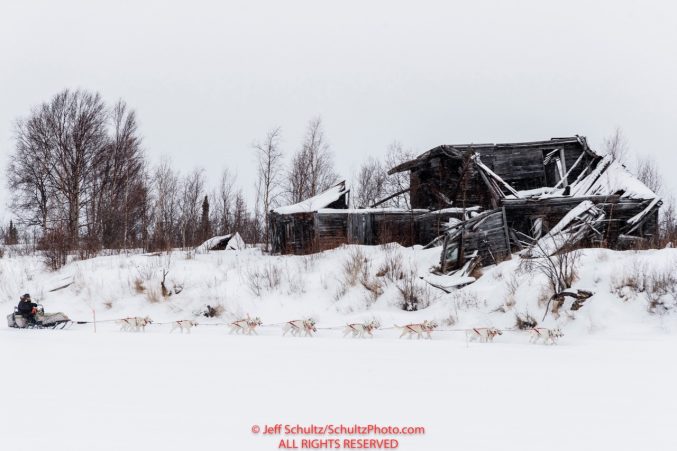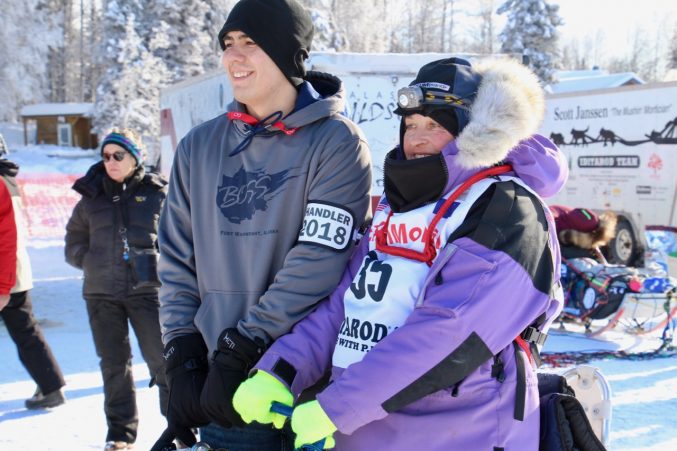The Back of the Pack is making steady progress to the Yukon River. Iditarod has once again returned to ghost town status. The last time it was populated was in 2013 when Iditarod followed the southern route to Nome. Back in its day, Iditarod was a town of 10,000 and the heart of the Iditarod Mining District. During the winter, dog teams hauled supplies and mail into Iditarod and departed with gold. During the period from 1908 – 1925, when gold was worth $20 an ounce, nearly $35 million in gold was taken from the area.
- Jim Lanier passes a derelict cabin on the trail into the Iditarod checkpoint on Friday, March 9th during the 2018 Iditarod Sled Dog Race
Don Bowers, in his trail notes gives an explanation of the sled dog in the gold rush. “The typical traveler on the Iditarod Trail was a musher driving a team of twenty or more dogs pulling a massive freight sled capable of carrying half a ton or more. These mushers followed in the ancient traditions of Alaska Natives, who mastered the fine art of using dogs for winter transportation many centuries ago.
When Russians and eventually Americans arrived in the North Country, they quickly discovered that dog teams were practically the only way to reliably move across long distances in Alaska when river travel was not possible. Indeed, they found that dogs were ideally suited for winter travel for a number of reasons.
Pound for pound, the sled dog is the most powerful draft animal on earth, and a team of twenty dogs averaging perhaps 75 pounds each can easily match a team of horses weighing more than twice as much. Dogs are faster than horses over the long haul, capable of maintaining average speeds of eight to twelve miles an hour for hundreds of miles (including rest stops. Even better, dogs can be fed from the land with moose, fish, or caribou in the winter, while horses or oxen require expensive hay or grain. Moreover, heavy draft animals cannot use the snowpacked winter trails.
The early mushers used a mixture of breeds, ranging from Native types such as the Malamute and Siberian husky to various domestic dogs imported from the Lower 48 (Jack London – Call of the Wild).”
Tom Schonberger is running in the Red Lantern position as he heads to Shageluk. Steve Watkins and Tara Cicatello are running just ahead of Tom. Mushers who’ve departed Shageluk and are on their way to Anvik include Marcelle Fressineau, Tim Muto and Magnus Kaltenborn. Jeff Deeter is the only veteran among a group including Alan Eishcens, Meredith Mapes, Anja Radano, Jason Stewart and Peter Fleck who have departed Anvik to run the Yukon River to Grayling.
- Jeff Deeter – Restart 2018
Twenty-nine year old Jeff Deeter grew up in Alaska. He began mushing as a teenager and ran his first Iditarod in 2008 before the age of twenty. Jeff calls Fairbanks, AK home. He and his wife, KattiJo own and operate Black Spruce Dog Sledding, a home-based tour business that introduces people to mushing and sled dogs and the lifestyle that surrounds the sport. Deeter says, “The times of sweat and hard work are immediately rewarded when you watch a team of dogs do what they truly enjoy. The satisfaction I get by traveling with my best friends is unmatched by anything in this world.” Deeter is out of Anvik with eight dogs averaging 7.0 miles per hour. In 2008 Deeter finished in 59th place with a time of 12 days, 13 hours and 11 minutes. Seventy-eight mushers finished the 2008 race.
- Marcelle Fressineau – Restart 2018
Swiss born Marcelle Fressineau thought she’d enter Iditarod once. But here she is back for her third trip to Nome. As a rookie in 2014, Marcelle survived the treacherous trail between Puntilla Lake and Nikola, finishing in 49th place to earn the Red Lantern. She returned in 2015 when the race was re-routed out of Fairbanks to finish 62nd. Now because of the decision to run the southern route for 2018, she’s seeing the much of the Iditarod Historic Trail. Fressineau has worked as an adventure outfitter in Switzerland. She began mushing in 1988 and started thinking about Iditarod. She moved to Canada in 1995 because it was a good place for dog mushing. She lives in the Yukon, running an outfitter business and raising Alaskan Huskies. She calls Iditarod the best experience I have made with my sled dogs. That’s why she’s entering again. Besides outdoor activities, also enjoys writing books. Fressineau will soon make the checkpoint of Anvik on the Yukon River. She’s traveling at an average speed of 6.8 miles per hour.




































